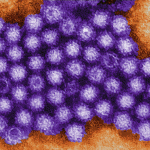Viral comments (8): unmarried couples in gastronomy?

As mentioned in previous blog entry join, there are virus-food couples solidly established as “riskier” from the point of view of their ability (historically recorded) to generate food-borne viral infections. We will develop in the following paragraphs.
- Norovirus and hepatitis A in bivalve molluscs. Multiple cases of transmission of norovirus and hepatitis A after consumption of bivalve molluscs have been reported. This direct association of risk is global range. A direct relationship of viral contamination of the food and previous sewage contamination of surrounding waters has been also thoroughly reported. Wastewater acts as a collector that gathers multiple shocks so that viral molluscs virus actively capture and indiscriminate, as filter feeders that are able to filter out tens of litres of water per day, may be two or more vehicles viral species. This leads to the distant possibility of appearance of recombinant viruses (unpredictable and undesirable) and the closest of unclear clinical symptoms and more severe. Norovirus infections are relatively common but usually cause a mild gastroenteritis. Infections by the hepatitis A virus are less common but more serious, and may even get worse as the proportion of vaccine-immune individuals decreases (since many years ago no vaccination against hepatitis A is performed).
- Norovirus and hepatitis A in fresh products. Well documented outbreaks with a clear tendency to generate large outbreaks (sometimes supranational); this is the case of outbreaks of gastroenteritis caused by berries (berries, strawberries, etc.) or contaminated green onions. It has been attributed the origin of the contamination, although not conclusively, to previous irrigation with polluted or contaminated waters.
- Norovirus and hepatitis A in processed products. It encompasses most of the reported cases, from food handling by infected persons who also didn’t stick routinely corresponding hygiene protocols. Any food manually processed by an infected person and then not treated, for example by cooking or frying is a potential source of infection. Asymptomatic carriers are a problem, but also those showing clinical symptoms as it has been described that once recovered from diarrhoea episode still are able to shed viruses for a while of time. Therefore some people postulate that affected employees should not come back to work until two days after remission of symptoms, at least. The personal hygiene is key issue here: wash your hands several times a day, and not only after going to the toilet, wear disposable gloves, etc. Even, in one study, kitchen hygiene has been correlated with infection rate (the lower hygiene, the higher likelihood of infection).
- Rotavirus in waters used for food preparation. Rotavirus is the leading cause of infant mortality by viral gastroenteritis (followed by norovirus and astrovirus) in the world and they are responsible for the deaths of more than one million children annually, particularly in developing countries. The use of water for reconstitution of powdered milks in these countries has been postulated as a likely source of transmission.
- New viruses, in particular food resources. We are facing the typical catchall box quite convenient, after all. Initial cases of SARS coronavirus transmission in the population were assigned to ingestion or handling of food (animals like civet, which possibly acquired it from the bats). The same can be extended to the case of H5N1 avian influenza (consumption of blood from infected animals in soups, meat was not properly cooked enough, etc.) and potential new pathogens yet to come. The global food market, with many foods produced in countries without proper food safety procedures; transport in friendly condition which may contribute to pathogens’ persistence, certain sectorial dietary changes advocating the consumption of raw or poorly cooked foods or demand of “exoticism signals” on the plate; changes at the level of primary production (farms) either by its intensification or opt for free range model, and finally the well-known but also clear climatic change with subsequent displacement of vectors and diseases will push or assist in further changes of the trends of foodborne disease. Probably new convenient virus–food couples will fall into this drawer.
In view of the above, when face foodborne infections have been known for decades but also the most recent and unexpected, and considering that the food market has become global, the development of pathways or mechanisms to control food-borne viral diseases should be a priority. One more priority among others, obviously.
But this, this is another story.













